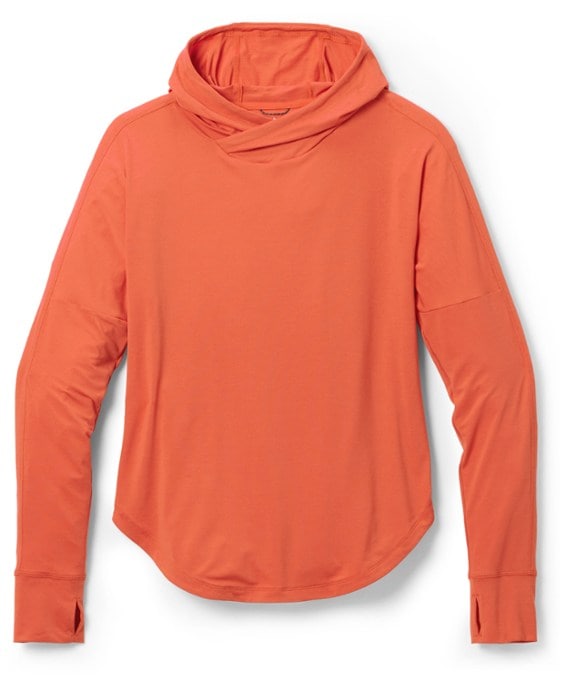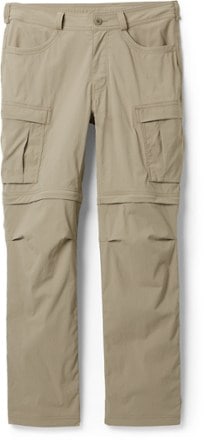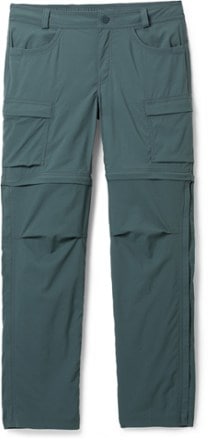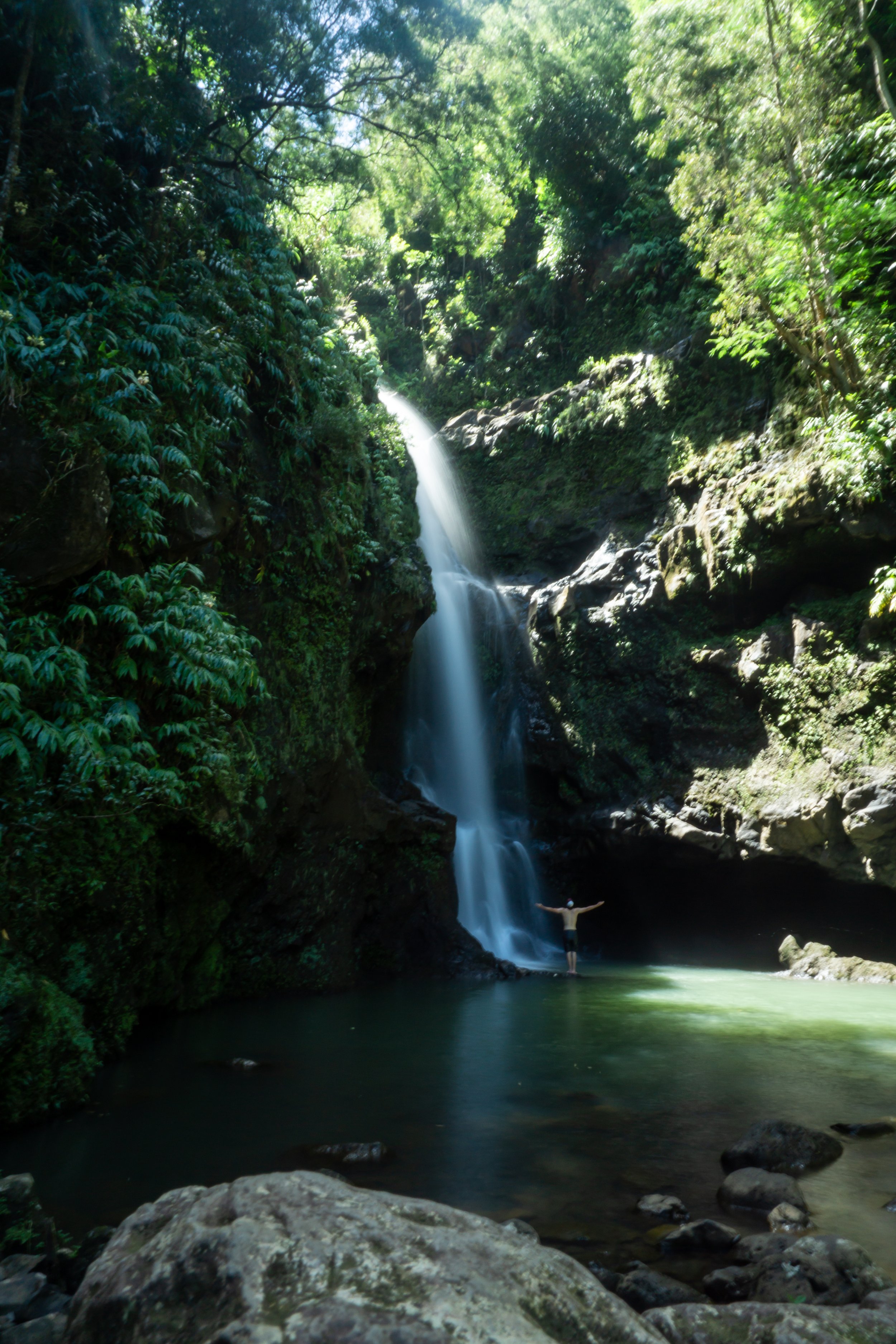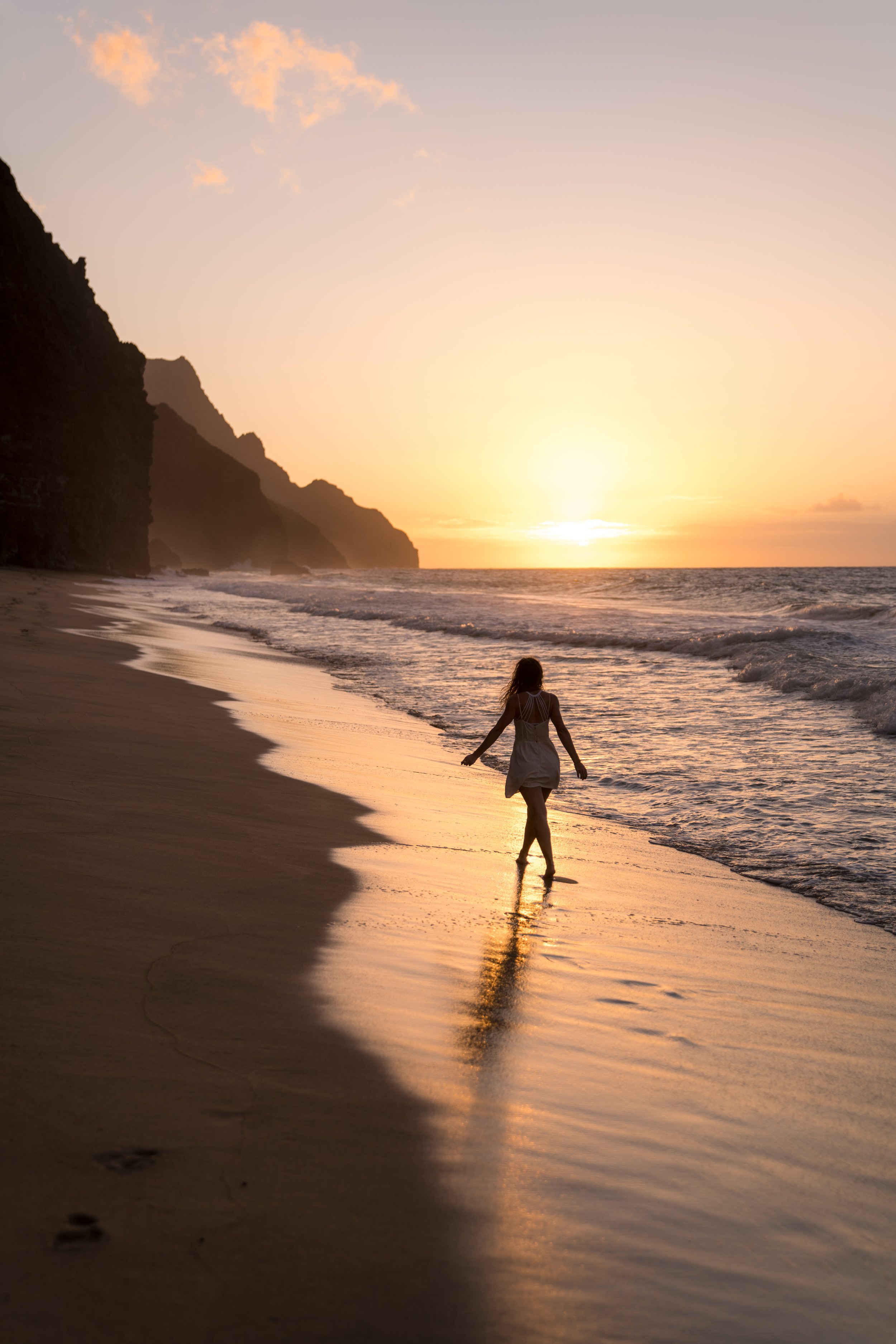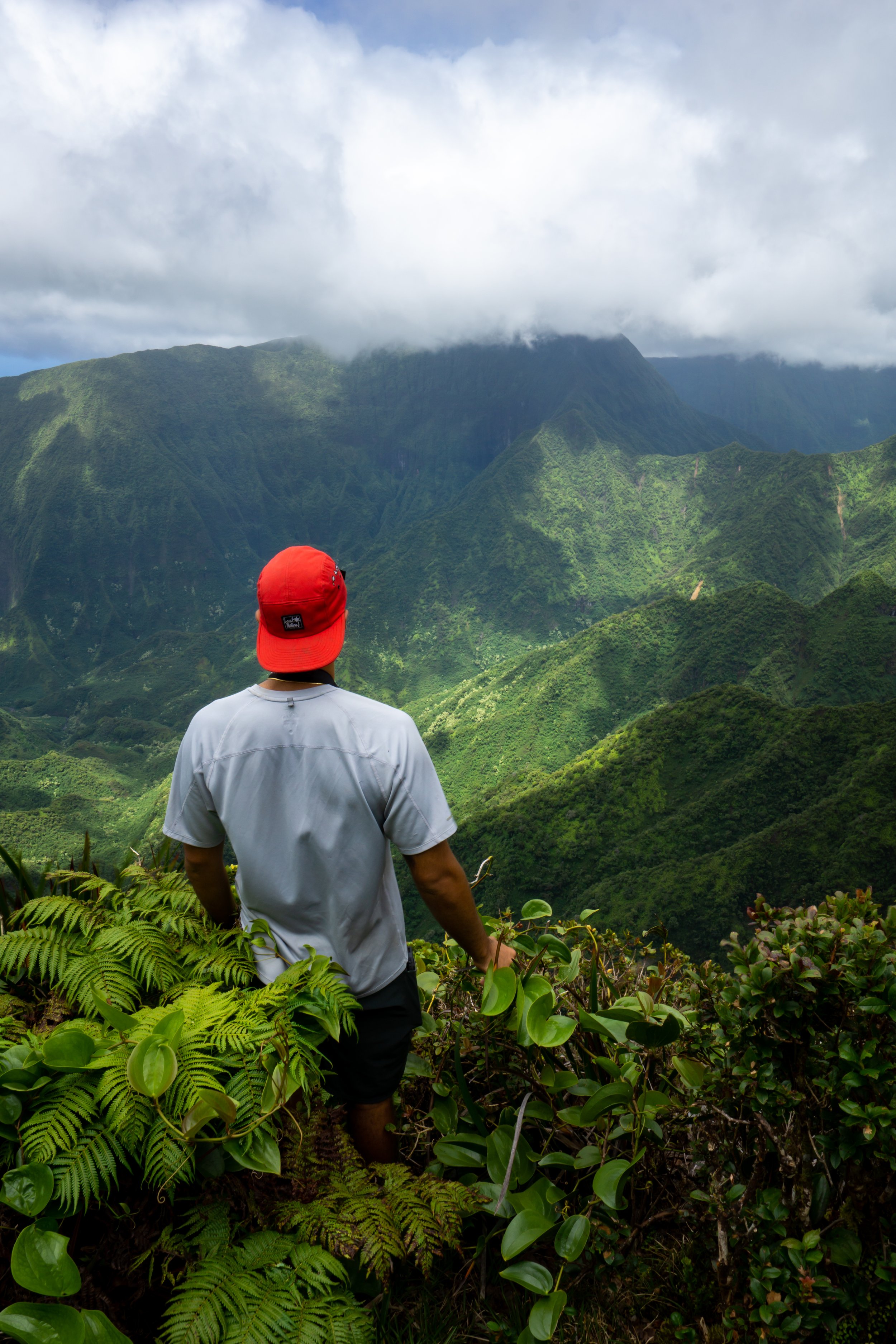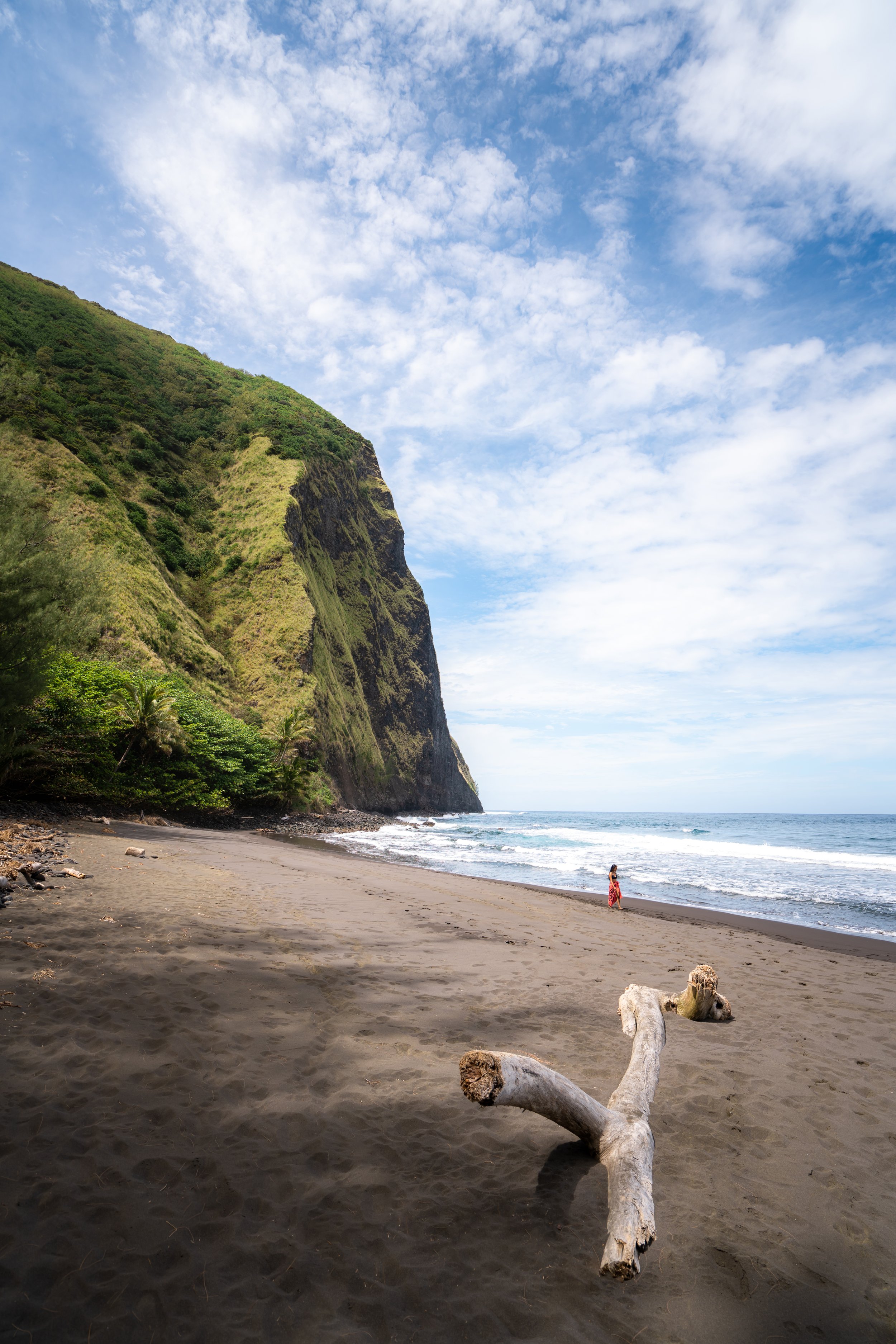Hiking the Koloiki Ridge-Kaiholena Ridge Loop Trail on Lānaʻi, Hawaiʻi
Distance (Roundtrip on Koloiki Ridge): 4.4 miles / 7.1 km
Distance (Full Koloiki-Kaiholena Loop): 6.4 miles / 10.3 km
The Koloiki Ridge Trail is, without a doubt, one of the best and most beautiful day hikes on Lānaʻi, as the trail has long been a favorite among both locals and visitors alike for many years!
Then, in mid-2024, a neighboring trail, known as the Kaiholena Ridge Trail, underwent a major renovation to make a once-seldom-trafficked hike accessible to the public.
This is not to say that Kaiholena Ridge is a new trail. In fact, the Kaiholena Ridge Trail has been used by locals for many years as a more direct route to the uppermost portions of the Munro Trail. However, following the 2024 renovation, the Kaiholena Ridge Trail is now much more enjoyable than ever, allowing hikers the option to combine Koloiki Ridge, the Munro Trail, and Kaiholena Ridge into one big loop, totaling 6.4 miles (10.3 km) roundtrip.
This is all to say that, whether you decide to hike out and back on the Koloiki Ridge Trail or further to complete the full loop, both day hikes are among the best things to do on Lānaʻi!
Koloiki-Kaiholena Loop Trailhead Parking
Parking for both Koloiki and Kaiholena Ridge is located at the Lānaʻi Adventure Park, just before the Sensei Four Seasons, on the way out of Lānaʻi City.
Yes, parking at the Adventure Park is free for hikers, and they even allow you the courtesy of filling up water and using the restroom—all at no cost!
Google Maps Directions: Koloiki Ridge-Kaiholena Ridge Loop Trailhead
My Hawaiʻi Hiking Checklist
Osprey 3L Water Bladder - The Osprey 3L water bladder is the most universal hiking and backpacking water bladder on the market, and it’s my go-to because of the slide-off seal that allows it to be quickly filled from the top. Additionally, individual parts are easily replaceable, such as the bite valve.
Blister / Heel Protectors - I swear by these cheap, amazing heel protectors to prevent blisters for nearly every kind of hiking and backpacking that I do!
Black Diamond Headlamp - Personally, I recommend the Black Diamond Storm because it is one of the brightest, lightest, and longest-lasting headlamps on the market—and trust me, the weight-to-battery-life ratio really does matter!
Hiking / Trail Running Shoes - Depending on the type of trail, I prefer to use either the Keen Targhee for longer, more rugged hiking or the HOKA Zinal Trail-Running Shoe for lighter, less intense trails. In either case, both have been amazing to me for many years across countless environments, and both can be found in men’s and women’s sizes. - (Men’s Keen / Women’s Keen) (Men’s HOKA / Women’s HOKA)
Waterproof Rain Shell - You never know when it may rain, and I’ve learned over the years that a rain shell is far better than a rain jacket. By this, I mean that it’s best to have something that the water will roll right off of, which is why I recommend the Patagonia Torrentshell 3L available in both men’s and women’s sizes.
High SPF Sunscreen - Packing high-SPF sunscreen is a must for long days outside!
Hiking the Koloiki Ridge-Kaiholena Ridge Loop Trail
Whether you decide to hike Koloiki or Kaiholena first, both trails follow the same paved path past the Adventure Park entrance up to the beginning of the loop, about 0.5 miles (0.8 km) away.
Koloiki-Kaiholena-Adventure Park Junction
This split off the road is the path that leads down to the Lānaʻi Adventure Park.
That said, stay on the road to the left to continue up to both Koloiki and Kaiholena Ridge.
It’s always great to see the Adventure Park and the Sensei Four Seasons supporting native Hawaiian plants!
When the Koloiki Ridge Trail comes to this four-way intersection just before the Cook Pine trees, go straight to continue toward the start of the loop.
After about 0.3 miles (0.5 km), the Koloiki Trail splits from the service road to the left
At the next split, go left once again to continue toward the beginning of the Koloiki-Kaiholena Loop Trail.
Koloiki Ridge-Kaiholena Ridge Junction (Loop Junction)
After 0.5 miles (0.8 km), both Koloiki Ridge and Kaiholena Ridge split from one another.
This is the beginning of the 5.4-mile (8.7 km) loop.
That being said, I chose to go straight to begin the Koloiki Ridge Trail first, returning later on the Kaiholena Ridge Trail at the end.
Once through the initial Strawberry Guava forest, the Koloiki Trail makes this hard left turn.
What is Kōʻele on Lānaʻi?
The signs that refer to Kōʻele here and on other trails across Lānaʻi are in reference to the leeward sides of mountains, as the name stems from moisture-laden clouds that descend the slopes from Kaiholena Valley to Lānaihale, creating a verdant environment in contrast to other, drier areas across Lānaʻi.
Today, Kōʻele is a common point of reference on Lānaʻi trails, which can more broadly be summarized as the trailhead, beginning, or civilization, as in Lānaʻi City.
It’s nice to see natives growing in this otherwise non-native Eucalyptus forest.
Koloiki Ridge-Munro Junction
Following the initial loop junction, the next time the Koloiki Ridge Trail splits is when it meets the Munro Trail.
From here, the Koloiki Ridge Trail follows the Munro Trail for roughly 0.8 miles (1.3 km) until it branches out onto the true Koloiki Ridge, leading to the viewpoint above Maunalei Gulch.
Along the Koloiki portion of the Munro Trail, there are a few instances where the trail splits, but the signs should always indicate the correct direction.
It truly is amazing how well the Koloiki Ridge Trail and others on Lānaʻi are marked, which is something that can’t be said about countless other trails across Hawaiʻi.
Agave is not native to Hawaiʻi, but it is quite a common species across Hawaiʻi’s dry forest landscapes, like the Kukui Trail in Kauaʻi’s Waimea Canyon.
At this next split, go left once again to stay on the much more trafficked Munro Trail.
Koloiki Ridge-Munro Junction
After 0.9 miles (1.4 km) on the Koloiki Trail and 0.8 miles (1.3 km) on the Munro Trail, the hike out to Koloiki Ridge leaves the Munro Trail at almost exactly the 1.7-mile (2.7 km) mark.
That being said, go left to continue on the Koloiki Ridge Trail to the viewpoint above Maunalei Gulch.
Koloiki Ridge Trail
Following the junction above, the true hike out to Koloiki Ridge begins, which, for many reasons, is the best and most scenic part of the entire hike!
This final stretch, from the Munro Trail to the viewpoint, measures about 0.5 miles (0.8 km) each way.
At this point, the canopy begins to open, and the views only get better and better the further you hike!
With that in mind, I highly recommend hiking in a hooded sun shirt if you’re interested in completing the full Koloiki Ridge-Kaiholena Ridge Loop, as both trails, along with the Munro Trail to connect the two, make for a bit of a long day in the sun!
For those biking, it is recommended that you leave your bike here and walk the remaining 0.1 miles (0.2 km) to the viewpoint.
I say this because the final sections are the narrowest on the entire hike, with a number of sharp, blind turns that can create a dangerous situation with other hikers.
Maunalei Gulch
The end of the Koloiki Ridge Trail is this overlook above Maunalei Gulch, the largest and deepest valley on Lānaʻi.
However, Maunalei Valley has a bit of an unfortunate history, transitioning from a once pristine native valley to one that has become severely altered by non-native ungulates stripping away the native vegetation, followed by invasive plant species taking their place.
This story is one that is not new in the Hawaiʻi conservation world, but rather, an age-old reality at this point across the Hawaiian Islands. This is why those in the conservation community work so hard to preserve what’s left of Hawaiʻi’s native forests, and it’s why I enjoy pointing out what you can expect to find as you hike Hawaiʻi’s trails today!
Furthermore, I highly encourage visiting the Kānepuʻu Preserve to see and actually get a sense of what Hawaiʻi’s native dryland forests are supposed to look like, which will also give you an appreciation for what those in the conservation community do to protect them!
Koloiki Ridge-Munro Junction
Once back at the Koloiki Ridge-Munro junction, most hikers turn back toward the Adventure Park to the right.
However, I chose to go left to continue up the Munro Trail to Kaiholena Ridge.
Munro Trail
From the Koloiki Ridge junction to the Kaiholena Ridge junction, the loop follows the Munro Trail for roughly 2.0 miles (3.2 km) until the split.
Expect the entire 2.0-mile (3.2 km) portion of the Munro Trail between Koloiki and Kaiholena Ridge to follow a slightly uphill trail, as the Munro Trail climbs all the way to Lānaihale, the highest peak on Lānaʻi.
The Munro Trail between Koloiki Ridge and Kaiholena Ridge may or may not be very well marked, as seen at this split here.
With that in mind, go right to continue around this big horseshoe-like turn to remain on the Munro Trail.
For those who don’t know, fences like this can be found not just across Lānaʻi, but all of Hawaiʻi, to protect pockets of native forest from non-native/ invasive ungulates that can severely damage the native landscape.
This is why I want to remind all to please make sure this and all gates are securely closed after you pass through.
This telecommunication building is always a nice sign that you’re on the correct trail.
As the Munro Trail climbs higher, the views out toward Hoʻokio and Maunalei Gulch open up a number of times before Kaiholena Ridge.
Be aware that, while the first 4.7 miles (7.6 km) to Koloiki Ridge and up the Munro Trail to Kaiholena Ridge may be accessible by bike, the Kaiholena Ridge Trail certainly is not—meaning that the only way to complete the full loop is by hiking.
While there are a handful of sparse ʻŌhiʻa lehua trees lower on the hike, they become much more frequent along these upper elevations.
These are some more views looking out toward Hoʻokio Gulch, with Maunalei Gulch beyond.
Kaiholena Ridge-Munro Junction
At roughly 2,700 ft. (823 m) and 4.7 miles (7.6 km) total, the Kaiholena Ridge Trail splits away from the Munro Trail to turn back toward Kōʻele and the Lānaʻi Adventure Park.
This is to say, go right to begin the 1.2-mile (1.9 km) Kaiholena Ridge Trail to return to the beginning.
It isn’t until Kaiholena Ridge that the loop begins to feel like a true Hawaiʻi trail.
By this, I mean that for the majority of Koloiki and the Munro Trail, the loop follows a series of 4WD roads, and it isn’t until Kaiholena Ridge that the loop begins to traverse an actual trail, similar to what you’d find on other islands, like the Kalauao Loop Trail on Oʻahu or the ʻĪao Valley Tableland Trail on Maui.
That being said, Kaiholena Ridge is easily the most difficult part of the entire hike, but that is not to say that it is difficult. It’s just more challenging that all the sections prior because it follows an actual trail.
Stay to the right at this 'split,' and remember there are no junctions on the Kaiholena Ridge Trail until the very bottom, where the loop first began.
Wearing pants, or at the very least convertible hiking pants, isn’t the worst idea on the Koloiki-Kaiholena Loop, so that you can wear shorts in the beginning and pants down Kaiholena Ridge, where the Uluhe is more overgrown.
However, in my experience, Kaiholena Ridge is nowhere near the worst in terms of overgrowth compared to trails on other islands. I only suggest this for those who may not be used to overgrowth in Hawaiʻi and would prefer the protection.
In any case, the pants below are my recommendations that hold up the best with the overgrowth here in Hawaiʻi, but with any hiking pants that need to be durable, make sure that they are at or near 100% nylon. This is really the most important factor!
At just 0.2 miles (0.3 km) down Kaiholena Ridge from the Munro Trail, the views toward Kōʻele really begin to open up!
Throughout these more exposed sections, I was very happy to have been wearing a hooded sun shirt.
Native plants, like this ʻŌhelo, are much more common on these upper elevations of the loop compared to Koloiki Ridge in the beginning.
This is the view out toward Molokai in the distance.
The overgrowth begins to subside about halfway down Kaiholena Ridge.
When the Kaiholena Ridge Trail makes this turn to the north, the trail begins to descend much more rapidly than the sections prior.
This, among many other obvious reasons, is why I said that the full loop isn’t bikeable.
Some hikers may prefer to carry trekking poles for these steeper sections down the Kaiholena Ridge Trail.
After the initial steep sections, the Kaiholena Ridge Trail levels off for a short distance before dropping down again to the beginning of the loop.
This hill marks the start of the final descent back to the beginning.
Just before the end, the Kaiholena Ridge Trail passes through the same fence from earlier on the Munro Trail.
Again, please remember to close the gate!
Koloiki Ridge-Kaiholena Ridge Junction
In total, the full Koloiki Ridge-Kaiholena Ridge Loop is 5.4 miles (8.7 km), excluding the initial 0.5 miles (0.8 km) walk each way from the Adventure Park.
On a different note, I personally think that the Koloiki Ridge Trail is one of the best day hikes on Lānaʻi—especially when hiked for sunrise!
Then, with the 'recent' 2024 improvement project to make Kaiholena Ridge a more accessible day hike, the full 6.4-mile (10.3 km) loop is one of the best, if not the best, adventure on the island!
I love this sign!
ᨒ 🤘🏼
Native Plants on the Koloiki-Kaiholena Loop Trail
The Koloiki-Kaiholena Loop Trail is easily one of the best day hikes to look for native plants on Lānaʻi, outside of the hike to Lānaihale and the short loop within the Kānepuʻu Preserve.
That said, some of the plants you can expect to see include Moa, ʻŌhiʻa lehua, Uluhe, Koa, ʻŌhelo, Palaʻā, ʻUhaloa, and ʻĀkia, to truly only name a few.
If you would like to learn more about these and many other native Hawaiian plants from across the islands, I encourage you to check out my separate post linked below.
Read My Separate Post: Native Hawaiian Plant Guide
More Lānaʻi Adventures
If you’re interested in reading about some more amazing Lānaʻi adventures, check out my separate posts below!
Best Hotels & Vacation Rentals on Lānaʻi
Although there aren’t a ton of places to stay on Lānaʻi, I recommend starting your search on VRBO.
This way, you can compare options in both Lānaʻi City and Mānele.
Best Way to Book Rental Cars!
I travel quite a bit, and I know firsthand that finding a good rental car deal can be a challenge, but that’s why I recommend comparing all of your options with Discover Cars.
In short, Discover Cars is a well-known, reputable business that allows you to search for the best deal across companies, and they have the best full-refund cancellation policy I’ve ever seen, valid up to 72, or sometimes even 48, hours prior to your reservation!
Book Here: Discover Cars
Visiting Other Islands
If you are visiting Lānaʻi or heading to another island, check out some of my personal recommendations for Oʻahu, Maui, Kauaʻi, Molokai, Lānaʻi, and Hawaiʻi Island (Big Island) in these separate posts.
If you’re trying to decide which island is right for your visit, check out my overview about each island in the post below.
Read My Separate Post: What is the Best Hawaiian Island to Visit?
What is the Best Time of Year to Visit Hawaiʻi?
The weather in Hawaiʻi can often appear to be warm and beautiful throughout the year, but in my experience, there is a lot more to consider when planning what time of year to visit the islands, such as what island you are considering, what sides of each island do you plan to stay, what activities are you most interested in, the wildlife, and countless other nuanced variables that can all impact the type of trip you can expect to have.
For these reasons, I highly recommend reading through my separate article to not only understand my thoughts regarding the best time of year to come to Hawaiʻi but also what you need to consider based on the time of year that you plan to visit.
Read My Separate Post: What is the Best Time of Year to Visit Hawaiʻi?
Safety
All hikes in Hawaiʻi should not be compared to trails outside of the islands, and hikers should exercise due caution on every adventure, given that many are extremely dangerous.
By this, I mean that Hawaiʻi is known for hot, humid weather, steep, dramatic, and unstable cliffs, and flash floods, which can occur without warning. Therefore, it is important that you check the local forecast, understand the physical condition of your entire group, and pack sufficient food and water before attempting any adventure.
Disclaimer
All information provided on this blog is for informational purposes only and is not intended to be a substitute for information or advice from qualified professionals or managing agencies.
Noah Lang Photography LLC makes no representations or warranties regarding the accuracy or completeness of the information provided here, and readers should use their own discretion, judgement, and seek professional advice where it is appropriate.
Furthermore, Noah Lang Photography LLC shall not be held responsible for any injuries, lost individuals, or legal issues arising from the use of information provided on this website, and if applicable, the above safety disclaimer should be referenced to provide a generic overview of the risks involved.
All said, the content on this blog is for the sole use of Noah Lang Photography LLC, and unauthorized use or reproduction of this content is strictly prohibited.
Disclosure
This post is not sponsored.
However, some of the links in this post are affiliate links, which means that I may earn a small commission if a purchase is made through one of those links. This commission comes at no additional cost to you, and I only recommend products that I personally use and believe will add value to my readers. Thank you for your support, which enables me to continue creating more!
To read the full privacy policy, click here.
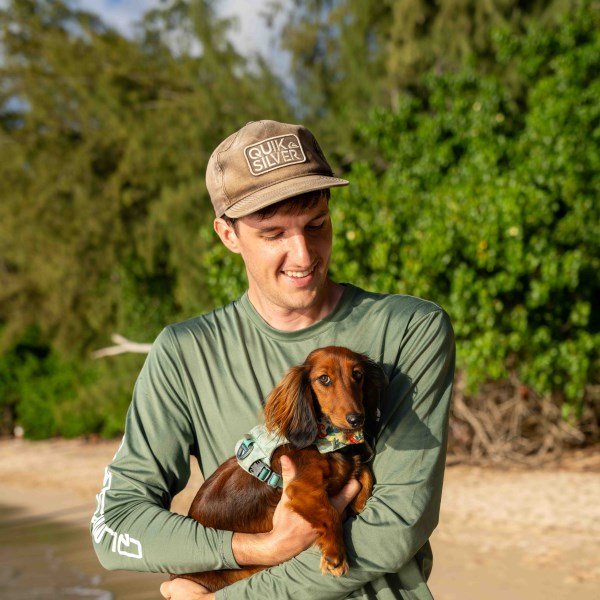
About This Blog
Noah Lang Photography, also known as @noahawaii, is 100% reader-supported!
I do not accept guest articles or sponsored content of any kind on my blog, which is why, if you enjoy the outdoor and travel content I create, please consider buying me a coffee!
I appreciate your support, which helps me continue to keep this blog alive!











